SUBARU TRIBECA 2014 1.G Manual Online
Manufacturer: SUBARU, Model Year: 2014, Model line: TRIBECA, Model: SUBARU TRIBECA 2014 1.GPages: 426, PDF Size: 6.37 MB
Page 81 of 426
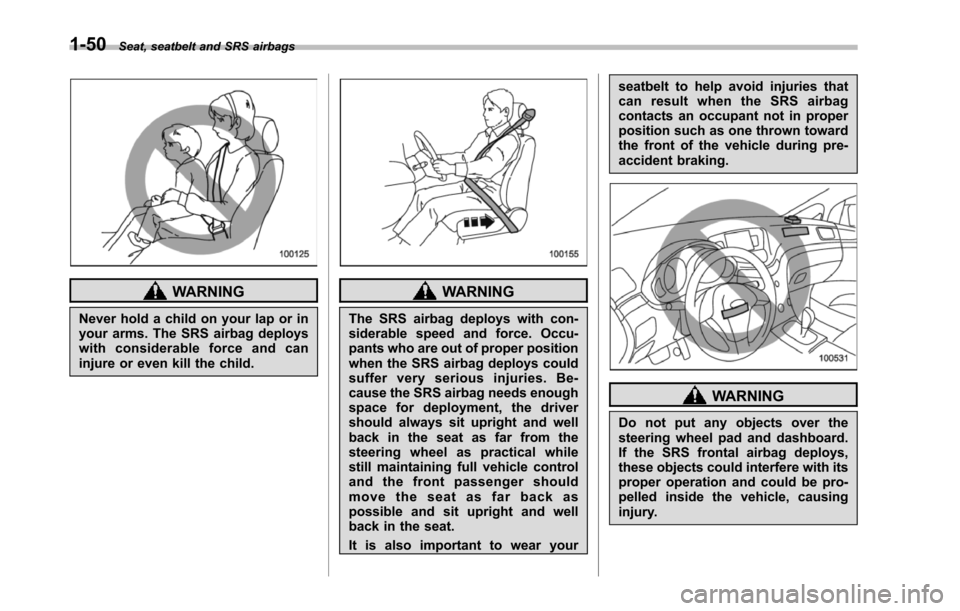
1-50Seat, seatbelt and SRS airbags
WARNING
Never hold a child on your lap or inyour arms. The SRS airbag deployswith considerable force and caninjure or even kill the child.
WARNING
The SRS airbag deploys with con-siderable speed and force. Occu-pants who are out of proper positionwhen the SRS airbag deploys couldsuffer very serious injuries. Be-cause the SRS airbag needs enoughspace for deployment, the drivershould always sit upright and wellback in the seat as far from thesteering wheel as practical whilestill maintaining full vehicle controland the front passenger shouldmove the seat as far back aspossible and sit upright and wellbackin the seat.
It is also important to wear your
seatbelt to help avoid injuries thatcan result when the SRS airbagcontacts an occupant not in properposition such as one thrown towardthe front of the vehicle during pre-accident braking.
WARNING
Do not put any objects over thesteeringwheel pad and dashboard.If the SRS frontal airbag deploys,these objects could interfere with itsproper operation and could be pro-pelled inside the vehicle, causinginjury.
Page 82 of 426
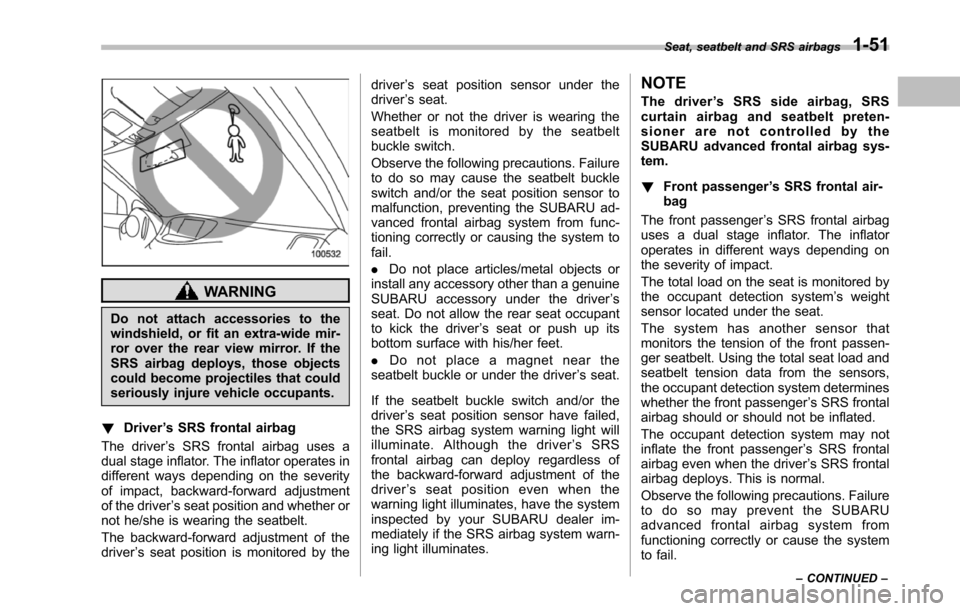
WARNING
Do not attach accessories to thewindshield, or fit an extra-wide mir-ror over the rear view mirror. If theSRS airbag deploys, those objectscould become projectiles that couldseriouslyinjure vehicle occupants.
!Driver’s SRS frontal airbag
The driver’s SRS frontal airbag uses adual stage inflator. The inflator operates indifferent ways depending on the severityof impact, backward-forward adjustmentof the driver’s seat position and whether ornot he/she is wearing the seatbelt.
The backward-forward adjustment of thedriver’s seat position is monitored by the
driver’s seat position sensor under thedriver’s seat.
Whether or not the driver is wearing theseatbelt is monitored by the seatbeltbuckle switch.
Observe the following precautions. Failureto do so may cause the seatbelt buckleswitch and/or the seat position sensor tomalfunction,preventing the SUBARU ad-vanced frontal airbag system from func-tioning correctly or causing the system tofail.
.Do not place articles/metal objects orinstall any accessory other than a genuineSUBARU accessory under the driver’sseat. Do not allow the rear seat occupantto kick the driver’s seat or push up itsbottom surface with his/her feet.
.Do not place a magnet near theseatbelt buckle or under the driver’s seat.
If the seatbelt buckle switch and/or thedriver’s seat position sensor have failed,the SRS airbag system warning light willilluminate. Although the driver’sSRSfrontal airbag can deploy regardless ofthe backward-forward adjustment of thedriver’sseatpositionevenwhenthewarning light illuminates, have the systeminspected by your SUBARU dealer im-mediatelyif the SRS airbag system warn-ing light illuminates.
NOTE
The driver’sSRSsideairbag,SRScurtain airbag and seatbelt preten-sioner are not controlled by theSUBARU advanced frontal airbag sys-tem.
!Front passenger’s SRS frontal air-bag
The front passenger’s SRS frontal airbaguses a dual stage inflator. The inflatoroperates in different ways depending onthe severity of impact.
The total load on the seat is monitored bythe occupant detection system’s weightsensor located under the seat.
The system has another sensor thatmonitors the tension of the front passen-ger seatbelt. Using the total seat load andseatbelt tension data from the sensors,the occupant detection system determineswhether the front passenger’s SRS frontalairbag should or should not be inflated.
The occupant detection system may notinflate the front passenger’s SRS frontalairbag even when the driver’s SRS frontalairbagdeploys. This is normal.
Observe the following precautions. Failureto do so may prevent the SUBARUadvanced frontal airbag system fromfunctioning correctly or cause the systemto fail.
Seat, seatbelt and SRS airbags1-51
–CONTINUED–
Page 83 of 426
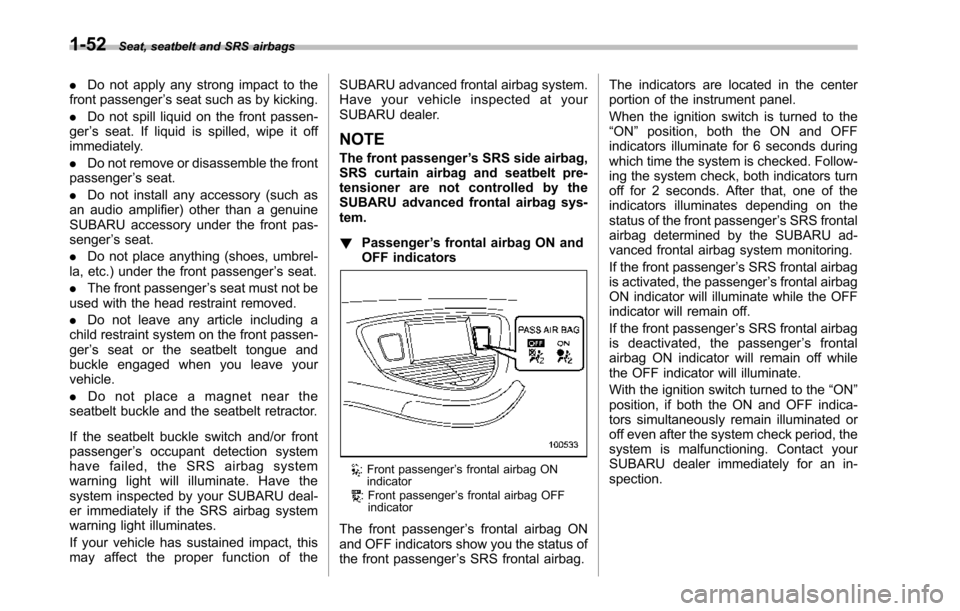
1-52Seat, seatbelt and SRS airbags
.Do not apply any strong impact to thefront passenger’s seat such as by kicking.
.Do not spill liquid on the front passen-ger’s seat. If liquid is spilled, wipe it offimmediately.
.Do not remove or disassemble the frontpassenger’s seat.
.Do not install any accessory (such asan audio amplifier) other than a genuineSUBARU accessory under the front pas-senger’s seat.
.Do not place anything (shoes, umbrel-la, etc.) under the front passenger’s seat.
.The front passenger’s seat must not beused with the head restraint removed.
.Do not leave any article including achild restraint system on the front passen-ger’s seat or the seatbelt tongue andbuckle engaged when you leave yourvehicle.
.Do not place a magnet near theseatbelt buckle and the seatbelt retractor.
If the seatbelt buckle switch and/or frontpassenger’s occupant detection systemhave failed, the SRS airbag systemwarning light will illuminate. Have thesystem inspected by your SUBARU deal-er immediately if the SRS airbag systemwarning light illuminates.
If your vehicle has sustained impact, thismay affect the proper function of the
SUBARU advanced frontal airbag system.Have your vehicle inspected at yourSUBARU dealer.
NOTE
The front passenger’s SRS side airbag,SRS curtain airbag and seatbelt pre-tensioner are not controlled by theSUBARU advanced frontal airbag sys-tem.
!Passenger’s frontal airbag ON andOFF indicators
: Front passenger’s frontal airbag ONindicator: Front passenger’s frontal airbag OFFindicator
The front passenger’s frontal airbag ONand OFF indicators show you the status ofthe front passenger’s SRS frontal airbag.
The indicators are located in the centerportion of the instrument panel.
When the ignition switch is turned to the“ON”position, both the ON and OFFindicators illuminate for 6 seconds duringwhich time the system is checked. Follow-ing the system check, both indicators turnoff for 2 seconds. After that, one of theindicators illuminates depending on thestatus of the front passenger’s SRS frontalairbag determined by the SUBARU ad-vanced frontal airbag system monitoring.
If the front passenger’s SRS frontal airbagis activated, the passenger’s frontal airbagON indicator will illuminate while the OFFindicator will remain off.
If the front passenger’s SRS frontal airbagis deactivated, the passenger’s frontalairbag ON indicator will remain off whilethe OFFindicator will illuminate.
With the ignition switch turned to the“ON”position, if both the ON and OFF indica-tors simultaneously remain illuminated oroff even after the system check period, thesystem is malfunctioning. Contact yourSUBARU dealer immediately for an in-spection.
Page 84 of 426
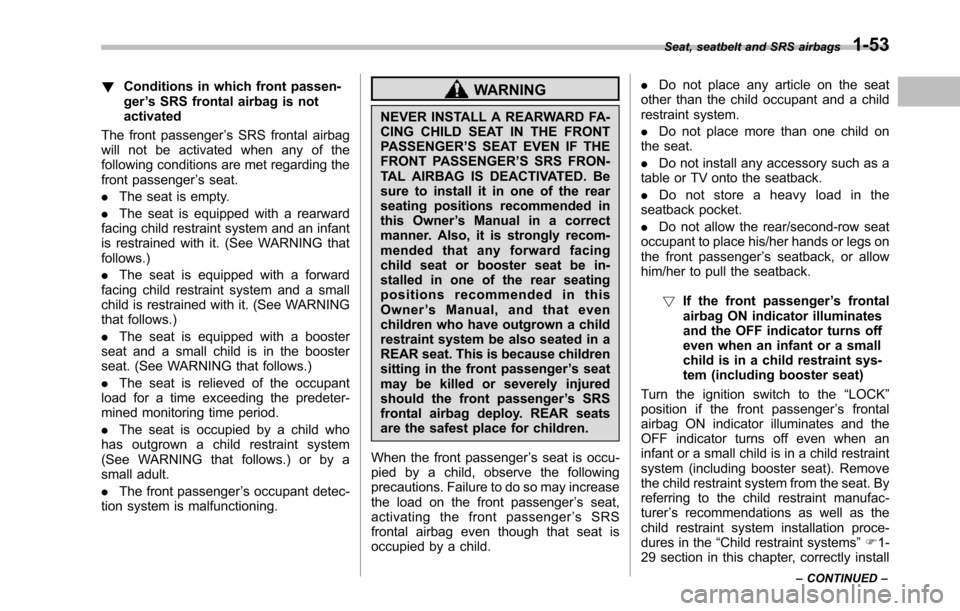
!Conditions in which front passen-ger’s SRS frontal airbag is notactivated
The front passenger’s SRS frontal airbagwill not be activated when any of thefollowing conditions are met regarding thefront passenger’s seat.
.The seat is empty.
.The seat is equipped with a rearwardfacing child restraint system and an infantis restrained with it. (See WARNING thatfollows.)
.The seat is equipped with a forwardfacing child restraint system and a smallchild is restrained with it. (See WARNINGthat follows.)
.The seat is equipped with a boosterseat and a small child is in the boosterseat. (See WARNING that follows.)
.The seat is relieved of the occupantload for a time exceeding the predeter-mined monitoringtime period.
.The seat is occupied by a child whohas outgrown a child restraint system(See WARNING that follows.) or by asmall adult.
.The front passenger’s occupant detec-tion system is malfunctioning.
WARNING
NEVER INSTALL A REARWARD FA-CING CHILD SEAT IN THE FRONTPASSENGER’S SEAT EVEN IF THEFRONT PASSENGER’S SRS FRON-TAL AIRBAG IS DEACTIVATED. Besure to install it in one of the rearseating positions recommended inthis Owner’s Manual in a correctmanner. Also, it is strongly recom-mended that any forward facingchild seat or booster seat be in-stalled in one of the rear seatingpositions recommended in thisOwner’sManual,andthatevenchildren who have outgrown a childrestraint system be also seated in aREAR seat. This is because childrensitting in the front passenger’s seatmay be killed or severely injuredshould the front passenger’s SRSfrontal airbag deploy. REAR seatsare the safest place for children.
When the front passenger’s seat is occu-pied by a child, observe the followingprecautions. Failure to do so may increasethe load on the front passenger’s seat,activating the front passenger’sSRSfrontal airbag even though that seat isoccupied by a child.
.Do not place any article on the seatother than the child occupant and a childrestraint system.
.Do not place more than one child onthe seat.
.Do not install any accessory such as atable or TV onto the seatback.
.Do not store a heavy load in theseatback pocket.
.Do not allow the rear/second-row seatoccupant to place his/her hands or legs onthe front passenger’s seatback, or allowhim/her to pull the seatback.
!If the front passenger’s frontalairbag ON indicator illuminatesand the OFF indicator turns offeven when an infant or a smallchild is in a child restraint sys-tem (including booster seat)
Turn the ignition switch to the“LOCK”position if the front passenger’s frontalairbag ON indicator illuminates and theOFF indicator turns off even when aninfant or a small child is in a child restraintsystem (including booster seat). Removethe child restraint system from the seat. Byreferring to the child restraint manufac-turer’s recommendations as well as thechild restraint system installation proce-dures in the“Child restraint systems”F1-29 section in this chapter, correctly install
Seat, seatbelt and SRS airbags1-53
–CONTINUED–
Page 85 of 426
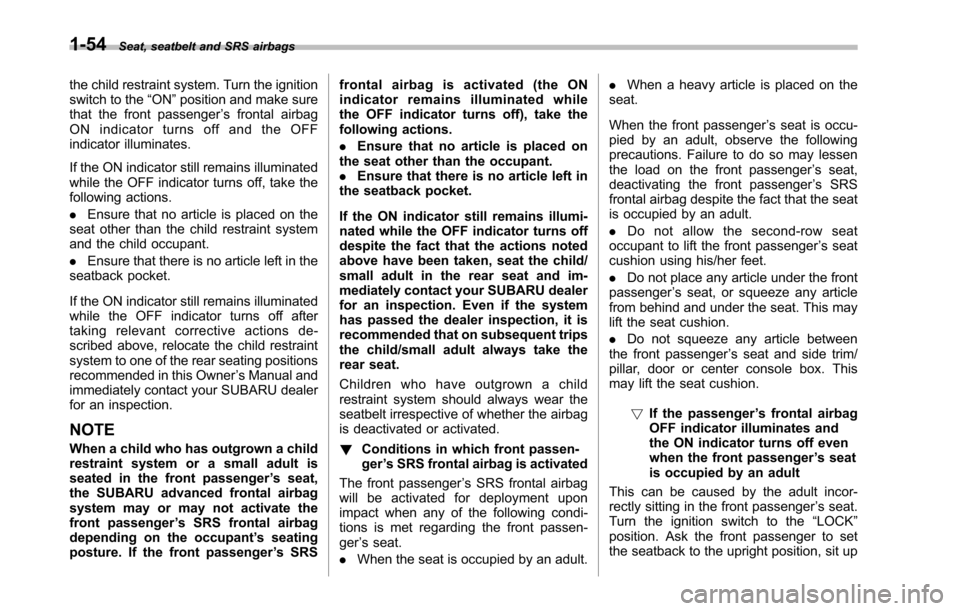
1-54Seat, seatbelt and SRS airbags
the child restraint system. Turn the ignitionswitch to the“ON”position and make surethat the front passenger’s frontal airbagON indicator turns off and the OFFindicator illuminates.
If the ON indicator still remains illuminatedwhile the OFF indicator turns off, take thefollowing actions.
.Ensure that no article is placed on theseat other than the child restraint systemand the child occupant.
.Ensure that there is no article left in theseatback pocket.
If the ON indicator still remains illuminatedwhile the OFF indicator turns off aftertaking relevant corrective actions de-scribed above, relocate the child restraintsystem to one of the rear seating positionsrecommended in this Owner’s Manual andimmediately contact your SUBARU dealerfor an inspection.
NOTE
When a child who has outgrown a childrestraint system or a small adult isseated in the front passenger’s seat,the SUBARU advanced frontal airbagsystem may or may not activate thefront passenger’s SRS frontal airbagdepending on the occupant’s seatingposture. If the front passenger’s SRS
frontal airbag is activated (the ONindicator remains illuminated whilethe OFF indicator turns off), take thefollowing actions.
.Ensure that no article is placed onthe seat other than the occupant..Ensure that there is no article left inthe seatback pocket.
If the ON indicator still remains illumi-nated while the OFF indicator turns offdespite the fact that the actions notedabove have been taken, seat the child/small adult in the rear seat and im-mediately contact your SUBARU dealerfor an inspection. Even if the systemhas passed the dealer inspection, it isrecommended that on subsequent tripsthe child/small adult always take therear seat.
Children who have outgrown a childrestraint system should always wear theseatbelt irrespective of whether the airbagis deactivated or activated.
!Conditions in which front passen-ger’s SRS frontal airbag is activated
The front passenger’s SRS frontal airbagwill be activated for deployment uponimpact when any of the following condi-tions is met regarding the front passen-ger’s seat.
.When the seat is occupied by an adult.
.When a heavy article is placed on theseat.
When the front passenger’s seat is occu-pied by an adult, observe the followingprecautions. Failure to do so may lessenthe load on the front passenger’s seat,deactivatingthe front passenger’s SRSfrontal airbag despite the fact that the seatis occupied by an adult.
.Do not allow the second-row seatoccupant to lift the front passenger’s seatcushion using his/her feet.
.Do not place any article under the frontpassenger’s seat, or squeeze any articlefrom behind and under the seat. This maylift the seat cushion.
.Do not squeeze any article betweenthe front passenger’s seat and side trim/pillar, door or center console box. Thismay lift the seat cushion.
!If the passenger’s frontal airbagOFF indicator illuminates andthe ON indicator turns off evenwhen the front passenger’s seatis occupied by an adult
This can be caused by the adult incor-rectly sitting in the front passenger’s seat.Turn the ignition switch to the“LOCK”position. Ask the front passenger to setthe seatback to the upright position, sit up
Page 86 of 426
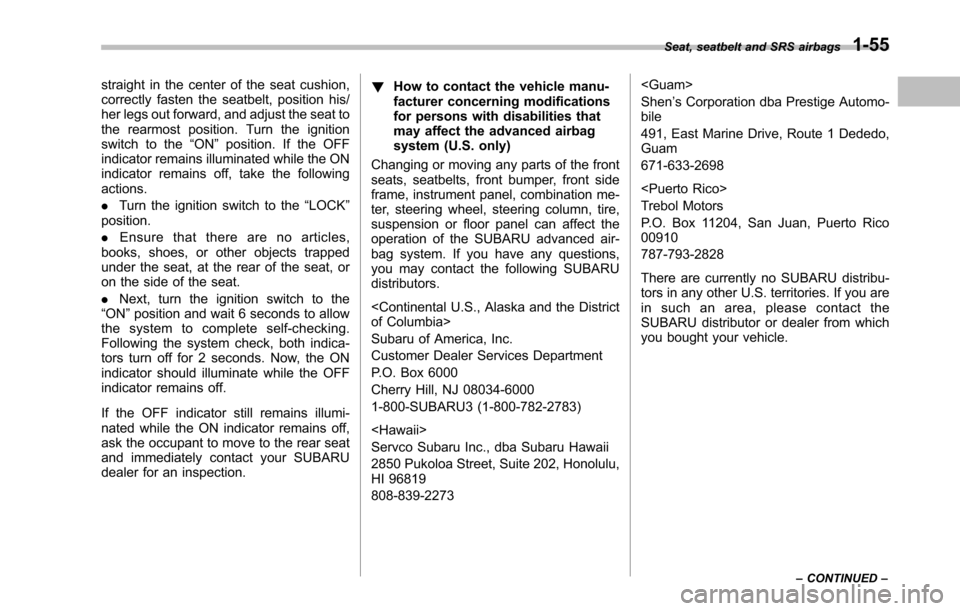
straight in the center of the seat cushion,correctly fasten the seatbelt, position his/her legs out forward, and adjust the seat tothe rearmost position. Turn the ignitionswitch to the“ON”position. If the OFFindicator remains illuminated while the ONindicator remains off, take the followingactions.
.Turn the ignition switch to the“LOCK”position.
.Ensure that there are no articles,books, shoes, or other objects trappedunder the seat, at the rear of the seat, oron the side of the seat.
.Next, turn the ignition switch to the“ON”position andwait 6 seconds to allowthe system to complete self-checking.Following the system check, both indica-tors turn off for 2 seconds. Now, the ONindicator should illuminate while the OFFindicator remains off.
If the OFF indicator still remains illumi-nated while the ON indicator remains off,ask the occupant to move to the rear seatand immediately contact your SUBARUdealer for an inspection.
!How to contact the vehicle manu-facturer concerning modificationsfor persons with disabilities thatmay affect the advanced airbagsystem (U.S. only)
Changing or moving any parts of the frontseats, seatbelts, front bumper, front sideframe, instrument panel, combination me-ter, steering wheel, steering column, tire,suspension or floor panel can affect theoperation of the SUBARU advanced air-bag system. If you have any questions,you may contact the following SUBARUdistributors.
Subaru of America, Inc.
Customer Dealer Services Department
P.O. Box 6000
Cherry Hill, NJ 08034-6000
1-800-SUBARU3 (1-800-782-2783)
Servco Subaru Inc., dba Subaru Hawaii
2850 Pukoloa Street, Suite 202, Honolulu,HI 96819
808-839-2273
Shen’s Corporation dba Prestige Automo-bile
491, East Marine Drive, Route 1 Dededo,Guam
671-633-2698
Trebol Motors
P.O. Box 11204, San Juan, Puerto Rico00910
787-793-2828
There are currently no SUBARU distribu-tors in any other U.S. territories. If you arein such an area, please contact theSUBARU distributor or dealer from whichyou bought your vehicle.
Seat, seatbelt and SRS airbags1-55
–CONTINUED–
Page 87 of 426
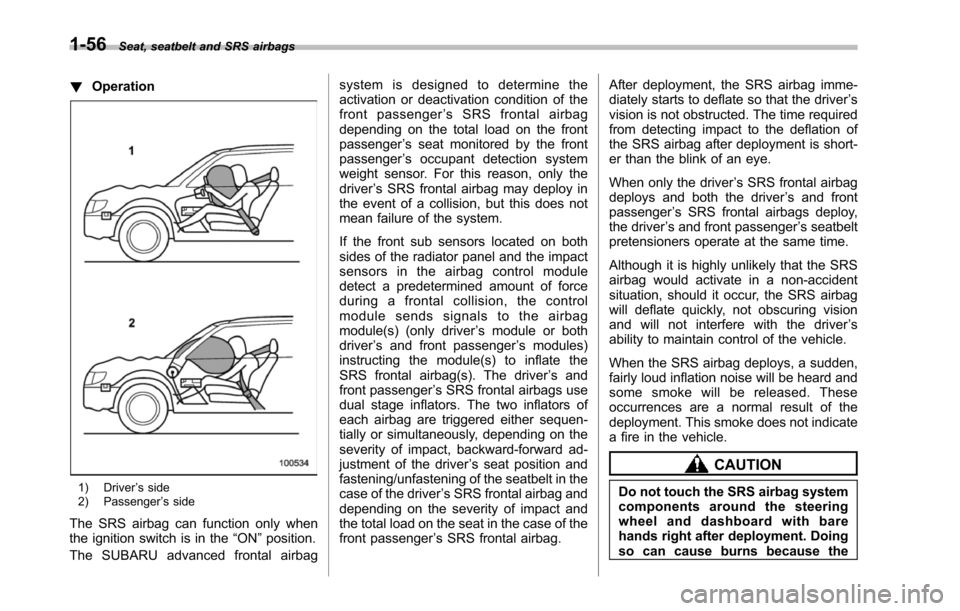
1-56Seat, seatbelt and SRS airbags
!Operation
1) Driver’s side2) Passenger’s side
The SRS airbag can function only whenthe ignition switch is in the“ON”position.
The SUBARU advanced frontal airbag
system is designed to determine theactivation or deactivation condition of thefront passenger’sSRSfrontalairbagdepending on the total load on the frontpassenger’s seat monitored by the frontpassenger’s occupant detection systemweight sensor. For this reason, only thedriver’s SRS frontal airbag may deploy inthe event of a collision, but this does notmeanfailure of the system.
If the front sub sensors located on bothsides of the radiator panel and the impactsensors in the airbag control moduledetect a predetermined amount of forceduring a frontal collision, the controlmodule sends signals to the airbagmodule(s) (only driver’s module or bothdriver’s and front passenger’s modules)instructing the module(s) to inflate theSRS frontal airbag(s). The driver’s andfront passenger’s SRS frontal airbags usedual stage inflators. The two inflators ofeach airbag are triggered either sequen-tially or simultaneously, depending on theseverity of impact, backward-forward ad-justmentof the driver’s seat position andfastening/unfastening of the seatbelt in thecase of the driver’s SRS frontal airbag anddepending on the severity of impact andthe total load on the seat in the case of thefront passenger’s SRS frontal airbag.
After deployment, the SRS airbag imme-diately starts to deflate so that the driver’svision is not obstructed. The time requiredfrom detecting impact to the deflation ofthe SRS airbag after deployment is short-er than the blink of an eye.
When only the driver’s SRS frontal airbagdeploys and both the driver’s and frontpassenger’s SRS frontal airbags deploy,the driver’s and front passenger’s seatbeltpretensioners operate at the same time.
Although it is highly unlikely that the SRSairbag would activate in a non-accidentsituation, should it occur, the SRS airbagwill deflate quickly, not obscuring visionand will not interfere with the driver’sability to maintain control of the vehicle.
When the SRS airbag deploys, a sudden,fairly loud inflation noise will be heard andsome smoke will be released. Theseoccurrencesare a normal result of thedeployment. This smoke does not indicatea fire in the vehicle.
CAUTION
Do not touch the SRS airbag systemcomponents around the steeringwheel and dashboard with barehands right after deployment. Doingso can cause burns because the
Page 88 of 426
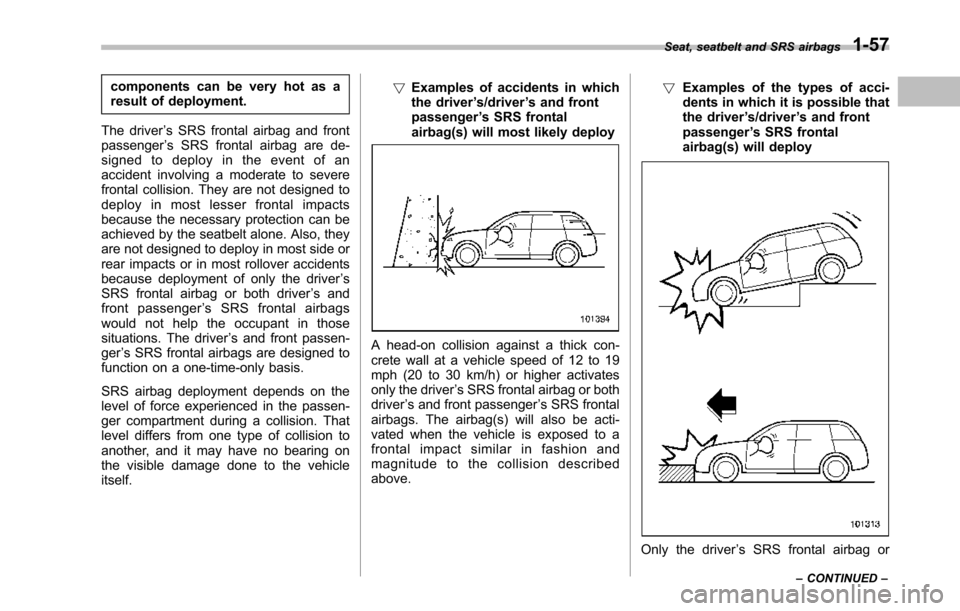
components can be very hot as aresult of deployment.
The driver’s SRS frontal airbag and frontpassenger’s SRS frontal airbag are de-signed to deploy in the event of anaccident involving a moderate to severefrontal collision. They are not designed todeploy in most lesser frontal impactsbecause the necessary protection can beachieved by the seatbelt alone. Also, theyare not designed to deploy in most side orrear impacts or in most rollover accidentsbecause deployment of only the driver’sSRS frontal airbag or both driver’s andfront passenger’sSRSfrontalairbagswouldnot help the occupant in thosesituations. The driver’s and front passen-ger’s SRS frontal airbags are designed tofunction on a one-time-only basis.
SRS airbag deployment depends on thelevel of force experienced in the passen-ger compartment during a collision. Thatlevel differs from one type of collision toanother, and it may have no bearing onthe visible damage done to the vehicleitself.
!Examples of accidents in whichthe driver’s/driver’s and frontpassenger’s SRS frontalairbag(s) will most likely deploy
A head-on collision against a thick con-crete wall at a vehicle speed of 12 to 19mph (20 to 30 km/h) or higher activatesonly the driver’s SRS frontal airbag or bothdriver’s and front passenger’s SRS frontalairbags. The airbag(s) will also be acti-vated when the vehicle is exposed to afrontal impact similar in fashion andmagnitude to the collision describedabove.
!Examples of the types of acci-dents in which it is possible thatthe driver’s/driver’s and frontpassenger’s SRS frontalairbag(s) will deploy
Only the driver’s SRS frontal airbag or
Seat, seatbelt and SRS airbags1-57
–CONTINUED–
Page 89 of 426
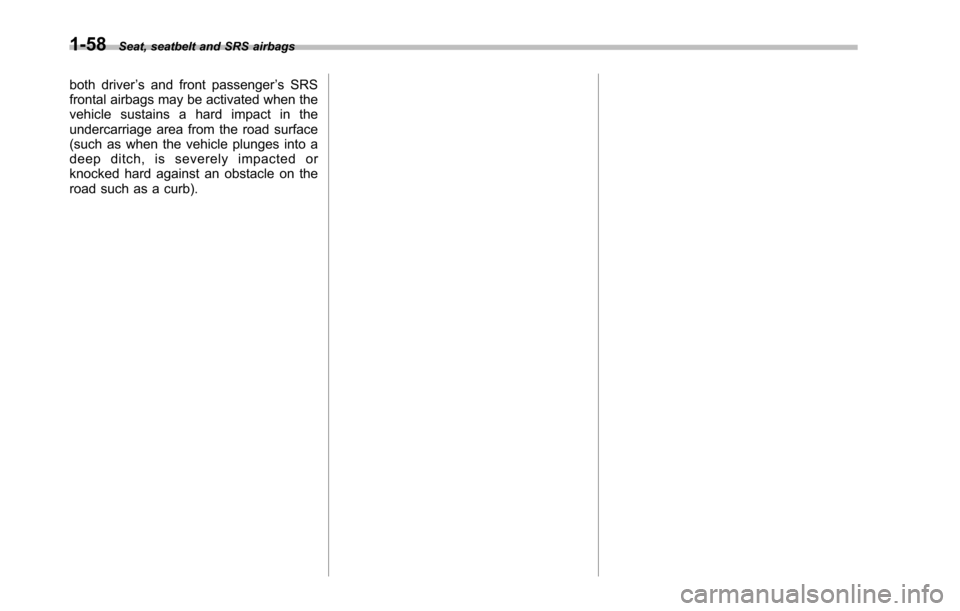
1-58Seat, seatbelt and SRS airbags
both driver’s and front passenger’s SRSfrontal airbags may be activated when thevehicle sustains a hard impact in theundercarriage area from the road surface(such as when the vehicle plunges into adeep ditch, is severely impacted orknocked hard against an obstacle on theroad such as a curb).
Page 90 of 426
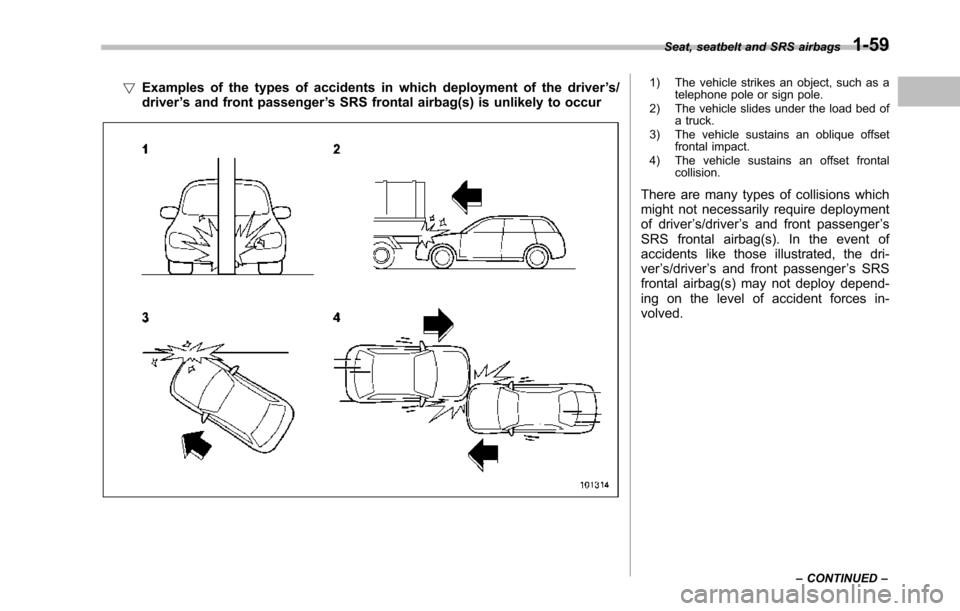
!Examples of the types of accidents in which deployment of the driver’s/driver’s and front passenger’s SRS frontal airbag(s) is unlikely to occur
1) The vehicle strikes an object, such as atelephone pole or sign pole.2) The vehicle slides under the load bed ofa truck.3) The vehicle sustains an oblique offsetfrontal impact.4) The vehicle sustains an offset frontalcollision.
There are many types of collisions whichmight not necessarily require deploymentof driver’s/driver’s and front passenger’sSRS frontal airbag(s). In the event ofaccidents like those illustrated, the dri-ver’s/driver’s and front passenger’s SRSfrontal airbag(s) may not deploy depend-ing on the level of accident forces in-volved.
Seat, seatbelt and SRS airbags1-59
–CONTINUED–